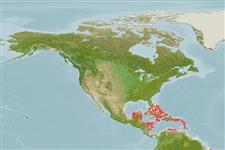Actinopterygii (ray-finned fishes) >
Perciformes (Perch-likes) >
Tripterygiidae (Triplefin blennies) > Tripterygiinae
Etymology: Enneanectes: Greek, ennea = nine times + Greek, nektos = that swimms (Ref. 45335).
Environment / Climate / Range
Ecology
Marine; reef-associated; depth range 0 - 10 m (Ref. 5521). Tropical, preferred ?
Western Central Atlantic: Bahamas to Puerto Rico.
Size / Weight / Age
Maturity: Lm ? range ? - ? cm
Max length : 4.0 cm TL male/unsexed; (Ref. )
Short description
Morphology | Morphometrics
Dorsal
spines
(total): 13 - 16;
Dorsal
soft rays
(total): 7-10;
Anal
soft rays: 15. Common amongst Tripterygiids: small, slender fishes. Cirri often present on top of eye and on rim of anterior nostril. Upper and lower jaws each with broad band of conical teeth. Three well-defined dorsal fins; first with 3 spines, second with 10 to 13 spines, third with 7 to 10 segmented rays; last dorsal-fin spine and first segmented ray borne on separate pterygiophores. Caudal fin with 13 segmented rays, 9 of which are branched; pelvic fin with 2 simple segmented rays and 1 embedded spine, inserted anterior to pectoral-fin base. Ctenoid scales on body; pectoral-fin base and belly naked or covered with cycloid scales. Lateral line interrupted at midbody, anterior lateral-line scales pored, posterior scales notched. Body coloration: brown or black bars on a pale (often red) background. Species distinguished by: pectoral-fin base and belly scaled; dorsum and pectoral-fin axil with enlarged scales; segmented anal-fin rays usually 15; pectoral-fin soft rays usually 15; pored lateral-line scales usually 13; anal fin uniformly pigmented; cheek behind eye naked or with 1 or 2 small cycloid scales (Ref.52855).
Adults are found on rocky and coral bottoms (Ref. 5521). Eggs are hemispherical and covered with numerous sticky threads that anchor them in the algae on the nesting sites (Ref. 240). Larvae are planktonic which occur primarily in shallow, nearshore waters (Ref. 94114). Very similar to E. pectoralis (Ref. 5521).
Life cycle and mating behavior
Maturity | Reproduction | Spawning | Eggs | Fecundity | Larvae
Böhlke, J.E. and C.C.G. Chaplin, 1993. Fishes of the Bahamas and adjacent tropical waters. 2nd edition. University of Texas Press, Austin. (Ref. 5521)
IUCN Red List Status (Ref. 115185)
CITES (Ref. 94142)
Not Evaluated
Threat to humans
Harmless
Human uses
More information
Age/SizeGrowthLength-weightLength-lengthLength-frequenciesMorphometricsMorphologyLarvaeLarval dynamicsRecruitmentAbundance
ReferencesAquacultureAquaculture profileStrainsGeneticsAllele frequenciesHeritabilityDiseasesProcessingMass conversion
Tools
Special reports
Download XML
Internet sources
